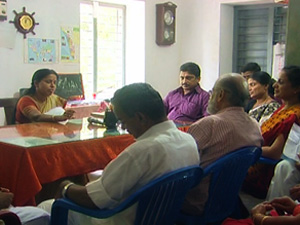We can demand accountability and transparency with these tools
Self-governance in action Back

The Kerala Panchayat Raj Act, 1994, gives panchayats in the state the power and authority to function as institutions of self-governance. This decentralization of power from the state government to the panchayats was initiated in Kerala in 1997–1998.
The Act mandates:
- transfer of functions to different local authorities.
- effective allocation of finances to different local authorities.
- participatory planning to ensure appropriate utilization of funds.
In fact, to make for just and development-oriented governance, gram sabhas have been given powers to:
- take decisions on the matters concerning their villages.
- oversee the administration of the local government.
- comment on its activities and participate in its decision-making.
Financial independence for gram panchayats
In Kerala, the state budget has a document exclusively for local self-governments, so that every gram panchayat knows how much money is being allocated to it. There are 978 gram panchayats in the state. Around 35% to 40% of state funds are kept for them and handed over as developmental grants.
The rules for spending these funds are simple:
- There is no fixed amount of funds allocated to panchayats for production or services.
- When it comes to infrastructure, gram panchayats and block panchayats cannot use more than 45% of the total funds; district panchayats cannot use more than 50%; and municipalities and corporations cannot use more than 55%.
- From the funds given for development, 10% must be reserved for women, and 5% for children, the elderly, the differently abled and other vulnerable groups.
(To read more about how the funds can be spent, click here.)
The Government of Kerala has also appointed four State Finance Commissions since 1997. These commissions suggest measures to strengthen the financial position of panchayats and municipalities, and give recommendations on appropriate taxes, duties, tolls and fees. Kerala is the only state where all the recommendations given by the four commissions have been adopted by the government.(To read more, click here.)
Community mobilization
Another unique feature of the gram panchayats in Kerala is the high level of neighbourhood-based community mobilization. Many of the central government programmes based on community mobilization have been very successful here. Also, Local Self-Government Institutions (LSGIs) have been empowered through massive transfer of resources as well as administrative powers. Coupled with a grassroots-level approach of participatory planning, the LSGIs have emerged as effective agencies for identifying and implementing development programmes through gram sabhas. (To read more, click here)